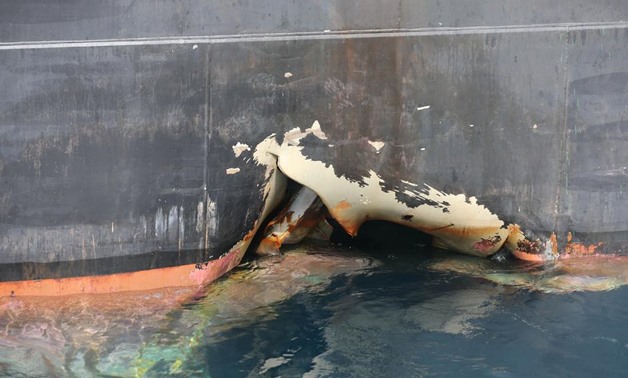
A damaged ANDREA VICTORY ship is seen off the Port of Fujairah, United Arab Emirates, May 13, 2019. REUTERS/Satish Kumar
CAIRO - 14 May 2019: A U.S. official told Time on Monday that an initial assessment by an American military team estimates that Iran or its proxies used explosives “to blow large holes” in four ships anchored in UAE’s Fujairah port.
The incident took place on Sunday in the port that is located near Hormuz Strait and 115 kilometers away from Iran. The four ships include two Saudi oil tankers, a Norwegian vessel and an Emirati bunkering tanker.
The official - who spoke on condition of anonymity - said, “each ship has a 5- to 10-foot hole in it, near or just below the water line.”
The publication reported that UAE has requested an investigation by an American team of military experts. Yet, no details or evidence have been revealed by U.S. or Emirati officials.
Fujairah Media Office negated in a tweet that strong bombings have shaken the port early on Monday urging media outlets to seek accurancy and depend on official shources.
The aircraft carrier strike group, USS Abraham Lincoln (CVN-72), left the Mediterranean and joined the U.S. 5th Fleet near Yemen in the Red Sea on Thursday earlier than planned upon a White House directive. That is “due to provocative behavior from Iran and new intelligence estimates,” according to U.S. Naval Institute News (USIN) website.
Reuters reported on Monday that Iran wants to export at least 1.5 million oil barrels per day as a condition to not pull out the Joint Comprehensive Plan of Action (JCPOA). The deal was signed in 2015 by Iran, the permanent members of the UN Security Council, and Germany to curb the first’s nuclear program.
In November, the United States reimposed sanctions on Iran’s oil exports. In May, the six-month waivers granted to top importers of Iranian oil expired. Consequently, Iran has threatened to block the Strait of Hormuz, which is a major shipping route of Gulf oil.
Since the sanctions went into force, Iran oil exports have more than halved to one million barrels per day or less from “a peak of” 2.8 million barrels per day last year, and “could drop to as low as 500,000 barrels per day from May,” as reported by Reuters.

Comments
Leave a Comment